The structure and stability of the monomorphic HLA-G are influenced by the nature of the bound peptide
- PMID: 20122941
- PMCID: PMC2905647
- DOI: 10.1016/j.jmb.2010.01.052
The structure and stability of the monomorphic HLA-G are influenced by the nature of the bound peptide
Abstract
The highly polymorphic major histocompatibility complex class Ia (MHC-Ia) molecules present a broad array of peptides to the clonotypically diverse alphabeta T-cell receptors. In contrast, MHC-Ib molecules exhibit limited polymorphism and bind a more restricted peptide repertoire, in keeping with their major role in innate immunity. Nevertheless, some MHC-Ib molecules do play a role in adaptive immunity. While human leukocyte antigen E (HLA-E), the MHC-Ib molecule, binds a very restricted repertoire of peptides, the peptide binding preferences of HLA-G, the class Ib molecule, are less stringent, although the basis by which HLA-G can bind various peptides is unclear. To investigate how HLA-G can accommodate different peptides, we compared the structure of HLA-G bound to three naturally abundant self-peptides (RIIPRHLQL, KGPPAALTL and KLPQAFYIL) and their thermal stabilities. The conformation of HLA-G(KGPPAALTL) was very similar to that of the HLA-G(RIIPRHLQL) structure. However, the structure of HLA-G(KLPQAFYIL) not only differed in the conformation of the bound peptide but also caused a small shift in the alpha2 helix of HLA-G. Furthermore, the relative stability of HLA-G was observed to be dependent on the nature of the bound peptide. These peptide-dependent effects on the substructure of the monomorphic HLA-G are likely to impact on its recognition by receptors of both innate and adaptive immune systems.
Figures
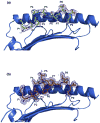
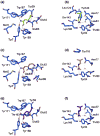
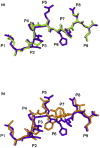
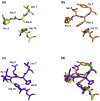
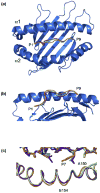


Similar articles
-
A conserved energetic footprint underpins recognition of human leukocyte antigen-E by two distinct αβ T cell receptors.J Biol Chem. 2017 Dec 22;292(51):21149-21158. doi: 10.1074/jbc.M117.807719. Epub 2017 Sep 25. J Biol Chem. 2017. PMID: 28972140 Free PMC article.
-
Structure and function of the human MHC class Ib molecules HLA-E, HLA-F and HLA-G.Immunol Rev. 1998 Jun;163:129-38. doi: 10.1111/j.1600-065x.1998.tb01192.x. Immunol Rev. 1998. PMID: 9700506 Review.
-
Classical and nonclassical class I major histocompatibility complex molecules exhibit subtle conformational differences that affect binding to CD8alphaalpha.J Biol Chem. 2000 May 19;275(20):15232-8. doi: 10.1074/jbc.275.20.15232. J Biol Chem. 2000. PMID: 10809759
-
Crystal structure of HLA-G: a nonclassical MHC class I molecule expressed at the fetal-maternal interface.Proc Natl Acad Sci U S A. 2005 Mar 1;102(9):3360-5. doi: 10.1073/pnas.0409676102. Epub 2005 Feb 17. Proc Natl Acad Sci U S A. 2005. PMID: 15718280 Free PMC article.
-
Structural studies on HLA-G: implications for ligand and receptor binding.Hum Immunol. 2007 Apr;68(4):220-6. doi: 10.1016/j.humimm.2006.09.003. Epub 2006 Oct 27. Hum Immunol. 2007. PMID: 17400055 Review.
Cited by
-
The Molecular and Functional Characteristics of HLA-G and the Interaction with Its Receptors: Where to Intervene for Cancer Immunotherapy?Int J Mol Sci. 2020 Nov 17;21(22):8678. doi: 10.3390/ijms21228678. Int J Mol Sci. 2020. PMID: 33213057 Free PMC article. Review.
-
Association of HLA-A and Non-Classical HLA Class I Alleles.PLoS One. 2016 Oct 4;11(10):e0163570. doi: 10.1371/journal.pone.0163570. eCollection 2016. PLoS One. 2016. PMID: 27701438 Free PMC article.
-
Clinical Significance of Potential Unidentified HLA-G Isoforms Without α1 Domain but Containing Intron 4 in Colorectal Cancer Patients.Front Oncol. 2018 Sep 4;8:361. doi: 10.3389/fonc.2018.00361. eCollection 2018. Front Oncol. 2018. PMID: 30234020 Free PMC article.
-
The importance of HLA-G expression in embryos, trophoblast cells, and embryonic stem cells.Cell Mol Life Sci. 2011 Feb;68(3):341-52. doi: 10.1007/s00018-010-0578-1. Epub 2010 Nov 16. Cell Mol Life Sci. 2011. PMID: 21080028 Free PMC article. Review.
-
Exploration of the Conformational Dynamics of Major Histocompatibility Complex Molecules.Front Immunol. 2017 May 29;8:632. doi: 10.3389/fimmu.2017.00632. eCollection 2017. Front Immunol. 2017. PMID: 28611781 Free PMC article. Review.
References
-
- Tynan FE, Borg NA, Miles JJ, Beddoe T, El-Hassen D, Silins SL, et al. High resolution structures of highly bulged viral epitopes bound to major histocompatibility complex class I: implications for T-cell receptor engagement and T-cell immunodominance. J Biol Chem. 2005;280:23900–23909. - PubMed
-
- Grimsley C, Kawasaki A, Gassner C, Sageshima N, Nose Y, Hatake K, et al. Definitive high resolution typing of HLA-E allelic polymorphisms: identifying potential errors in existing allele data. Tissue Antigens. 2002;60:206–212. - PubMed
-
- Lajoie J, Boivin AA, Jeanneau A, Faucher MC, Roger M. Identification of six new HLA-G alleles with non-coding DNA base changes. Tissue Antigens. 2009;73:379–380. - PubMed
Publication types
MeSH terms
Substances
Grants and funding
LinkOut - more resources
Full Text Sources
Molecular Biology Databases
Research Materials

